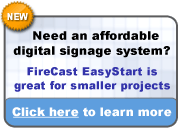For anybody that hasn't been following the saga of Wireless Ronin, they're a small digital signage company noteworthy only because they managed to go public on the Nasdaq about a year ago at an improbably high valuation. In early November of last year (2006), we took
a technical look at the company's SEC filings and came to the conclusion that for every $1 that came in, a bit more than $4 went out, for a net loss of $3 for every dollar of revenues. Despite this, they did manage to complete an initial offering and even a follow-on offering later this year that put a ton of cash into their coffers. At one point this year, their stock traded at over $10/share, giving them a valuation of over $100M.
Unfortunately, what they failed to mention to their investors was that lots and lots of potential clients in the digital signage industry are little more than start-up companies with lots of hope and good ideas, but little ability to execute. What's more, even good-looking projects with great prospects can get delayed, for months, years, and sometimes indefinitely. That has hurt RNIN, since they had to drop their earnings estimate for 2007 from the initial guess of $18-20M, to a much more modest $4-6M. Worse, looking at their
third quarter numbers, RNIN committed one of the cardinal sins of digital signage: extending a large credit line to a small company. When you're selling software, it's easy to get lulled into the trap of extending a much larger credit line than a customer might be worthy of. After all, software doesn't often carry that high a cost of sale (unless you're licensing lots of components, have to pay royalties, etc.) But in RNIN's case, "for the third quarter of 2007, year-to-date gross margins averaged 38.6 percent, compared to a gross margin of 60.1 percent through the first three quarters of 2006. Gross margin levels in 2007 continue to re-build from 2006 as a greater percentage of higher-margin software revenue continues to get added into the product mix." So they fronted hard assets (hardware) as well as billable person-hours ("services," probably content creation or project management), which is a much more aggressive stance to take, since if your clients don't pay you, it's hard to reclaim the former and basically impossible for the latter.
And that's more or less what has happened. Earlier this year RNIN
announced an agreement with a small company called NewSight Corporation to roll out digital signs to 2,000 doctors offices across the country as well as a network of large displays in shopping malls. From earlier earnings calls, it sounded like RNIN would be supplying everything -- hardware, software, content and logistics -- to make the networks happen. But we're now guessing that they "sold" some units to NewSight, gave them generous terms, but have not been able to collect. That leaves RNIN in the uncomfortable position of having a very large accounts receivable (it's nearly 3/4th of their YTD sales), most of which is in the hands of a company that may well never be able to pay them.
The only upside is that the company still has nearly $30M in the bank which will allow them to recover from the mistake should NewSight default on the debt, and it's enough that RNIN could even deploy and operate the network themselves if they wanted to.
The moral of the story? Even the best-intentioned companies can fail to execute, and even the best-laid plans can be put on hold forever. Unless it's your business, don't go loaning out money, goods or services to untested companies unless you and your investors all understand the industry well enough to estimate the true risk of doing so.
Tags:
Wireless Ronin,
RNIN,
digital signageNote: The information contained in this blog is to be used for entertainment purposes only. I'm not a lawyer, accountant or financial professional, nor am I qualified to pick stocks, set prices or give any kind financial or stock market advice. Disagree with something I've said? Let me know why in a comment.


 I somehow missed
I somehow missed  Subscribe to this blog
Subscribe to this blog Follow Bill Gerba on Twitter
Follow Bill Gerba on Twitter